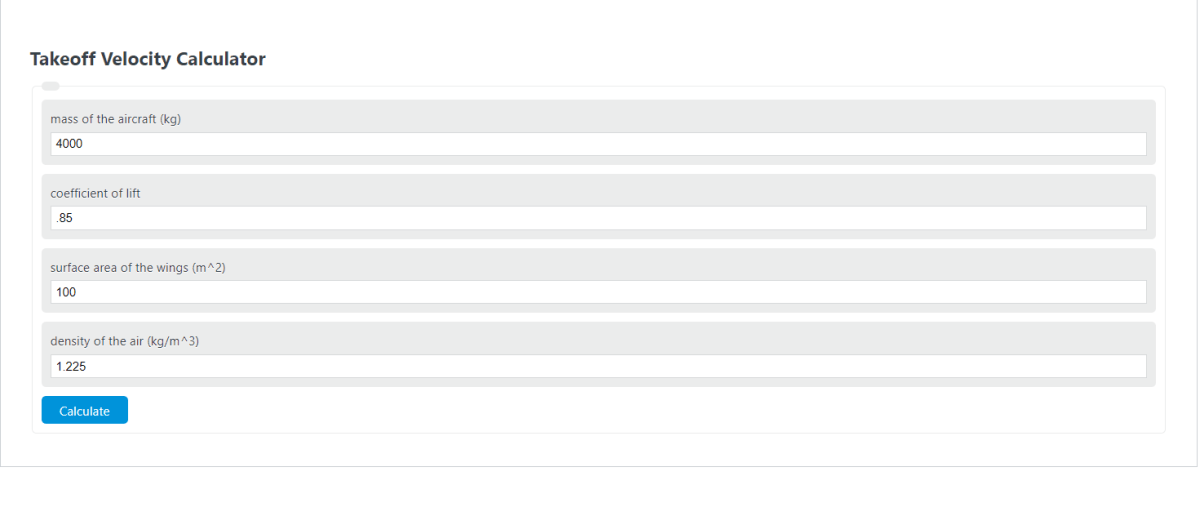Enter the weight of the aircraft, the coefficient of lift, the wing surface area, and the density of the air into the calculator to determine the takeoff velocity.
Takeoff Velocity Formula
The following equation is used to calculate the Takeoff Velocity.
V = SQRT (2*m*g / (CL*A*d))
- Where V is the Takeoff Velocity (m/s)
- m is the mass of the aircraft (kg)
- g is the acceleration due to gravity (9.81m/s^2)
- CL is the coefficient of lift
- A is the surface area of the wings (m^2)
- d is the density of the air (kg/m^3)
To calculate the takeoff velocity, divide the product of 2 times the mass times g by the product of the coefficient of lift, the surface area of the wings, and the density of the air, then take the square root of the result.
What is a Takeoff Velocity?
Definition:
A takeoff velocity describes the speed at which the lift force is equal to the mass of the aircraft.
How to Calculate Takeoff Velocity?
Example Problem:
The following example outlines the steps and information needed to calculate Takeoff Velocity.
First, determine the mass of the aircraft. In this example, the mass is found to be 4000kg.
Next, determine the coefficient of lift. For this problem, the coefficient of lift is found to be .85.
Next, determine the surface area of the wings. In this case, the area is measured to be 100 m^2.
Next, determine the density of the air. For this, the air density is 1.225 kg/m^3.
Finally, calculate the Takeoff Velocity using the formula above:
V = SQRT (2*m*g / (CL*A*d))
V = SQRT (2*4000*9.81 / (.85*100*1.225))
V = 27.453 m/s
FAQ
What factors can affect the takeoff velocity of an aircraft?
The takeoff velocity of an aircraft can be affected by several factors including the aircraft’s weight, the wing surface area, the air density (which can vary with altitude and weather conditions), and the coefficient of lift, which can change based on the wing’s design and the angle of attack during takeoff.
How does air density impact aircraft performance during takeoff?
Air density plays a crucial role in aircraft performance during takeoff. Higher air density (found in cooler temperatures or at lower altitudes) increases the air’s resistance against the wing, resulting in higher lift at lower speeds. Conversely, lower air density (found in warmer temperatures or at higher altitudes) reduces lift, requiring higher takeoff velocities to achieve the necessary lift for takeoff.
Can the takeoff velocity formula be applied to any type of aircraft?
While the basic principles of the takeoff velocity formula apply broadly, specific calculations may vary depending on the type of aircraft. Factors such as wing design, engine power, and aircraft weight distribution can influence the exact takeoff velocity. It’s essential for calculations to be tailored to the specific characteristics of the aircraft in question.
